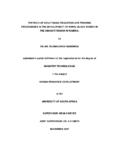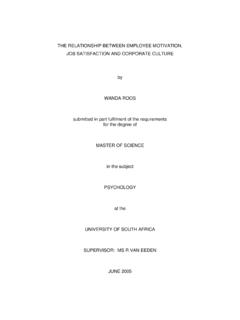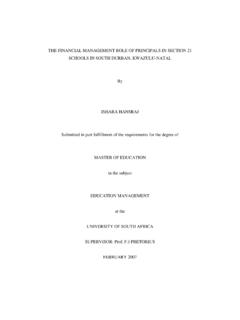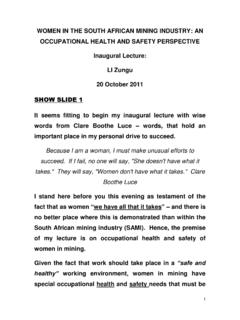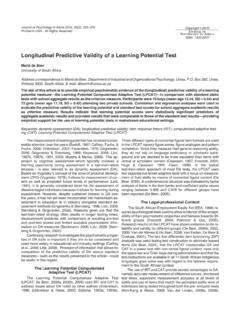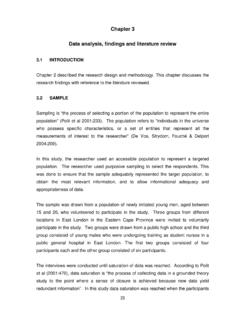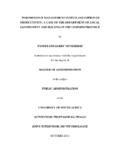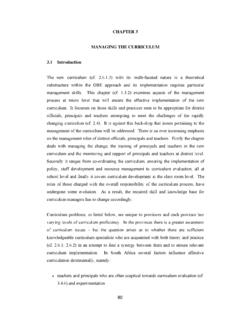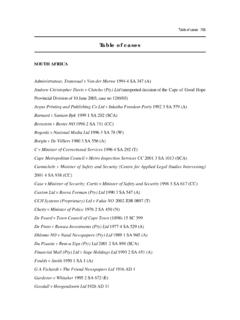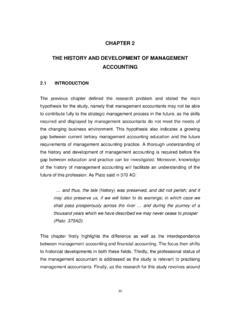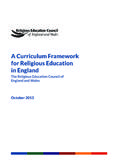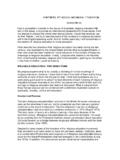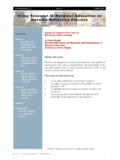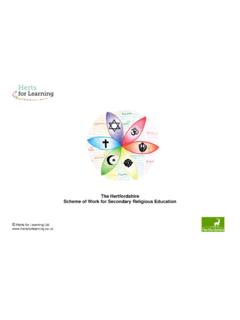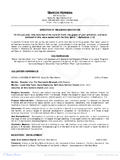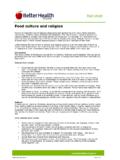Transcription of CHAPTER 3 VARIOUS APPROACHES TO RELIGIOUS …
1 CHAPTER 3. VARIOUS APPROACHES TO RELIGIOUS education TEACHING WITH. SPECIAL REFERENCE TO ZIMBABWE. 1. INTRODUCTION. According to scholars such as Thompson (1977:43), many critics prior to independence tend to argue that the educational systems of developing countries including Zimbabwe, were patterned on imported (the colonial) models and therefore bound to be irrelevant. With the advent of independence from Britain in 1980, the quest for relevance in education also with regard to RELIGIOUS education , therefore became of great concern (see CHAPTER 1, pp. 2-3). The government of Zimbabwe immediately questioned the relevance of the imported British curriculum.
2 Concern was also raised on the methods or APPROACHES used in teaching learners the VARIOUS subject curricula (see CHAPTER 1, pp. 3- 4). This CHAPTER seeks to explore two vital APPROACHES used in RELIGIOUS education teaching: the life experience approach and the multi-faith approach. These APPROACHES respectively were introduced and are in the process of being introduced as part of government effort to make RELIGIOUS education relevant to the Zimbabwean society (see CHAPTER 1, pp. 1-6). An essential part of the strategy of the government in making RELIGIOUS education relevant to the Zimbabwean learner involved the introduction soon after independence of 112.
3 The life experience approach. The government, educational administrators and curriculum developers were convinced that education must relate to the life situation of the Zimbabwean learner and thus become more relevant (see CHAPTER 1, pp. 1-6). For example, Thompson (1977:44) argues in this respect: One of the more important criticisms which educationists have faced and is a criticism which has been loudly voiced over half a century is that education which should be fitting the child for life in his society tends instead to divorce the child from his culture and to render him unwilling to return to the life of the community from which he sprung.
4 Kenyatta (1965:124) comprehensively dealt with the issue, many years ago, and concluded that the African finds that socially and religiously he has been torn away from his family and tribal organisation . Imported patterns of formal education including RELIGIOUS education teaching are thus viewed by many scholars (Machokoto 1983;. Maravanyika 1981) as promoting the breakdown of traditional societies. The introduction of the life experience approach since independence was among others an attempt by the government of Zimbabwe to re-unite the Zimbabwean learner with his/her cultural and traditional heritage.
5 The government, however, from 1997 onwards advocated for a multi-faith approach to RELIGIOUS education teaching as it realised and acknowledged the presence of members of other religions besides Christianity in Zimbabwe society, and, consequently schools (Curriculum Development Unit 1999:1). A multi-faith approach to RELIGIOUS education teaching was seen as a way to address the diversity of RELIGIOUS beliefs and practices of the peoples of Zimbabwe (see CHAPTER 1, p. 20). 113. The introduction of new teaching APPROACHES in RELIGIOUS education in Zimbabwe after independence was also seen as leading to a paradigm shift in the pedagogy of Zimbabwean secondary schools.
6 This pedagogy was, according to Dzvimbo (1995:1). reflective, liberatory and emancipatory so as to address the way teachers teach and students learn . As noted previously (see CHAPTER 1, pp. 2-3), the Rhodesian educational system was a carbon copy of the British system. The emphasis was on rote learning and content only. The new pedagogy aimed not only to increase the general knowledge of the learners, but also to develop their understanding, critical thinking, skills, values and attitudes. It focused not only on what the learner learnt, but how the learner learnt. In other words, the process of learning became just as important as what the learner learnt.
7 More importance was now attached to what learners did with the knowledge they acquired than to whether they knew all the facts off by heart. Content was still important, but was only of value if it could be used to develop the skills and values of learners. The approach aimed at equipping all learners with the knowledge, skills, values and attitudes needed for success after they have completed the subject. Its guiding vision was a thinking, competent future citizen of Zimbabwe (Schoeman 2001:4-5). Against the above introductory remarks, the VARIOUS APPROACHES to RELIGIOUS education teaching implemented in Zimbabwe since independence will be discussed.
8 Firstly, this CHAPTER seeks to examine the life experience approach to RELIGIOUS education teaching, with special reference to its origins, rationale, characteristics and advantages and disadvantages. Secondly, the multi-faith approach to RELIGIOUS education teaching will 114. be examined, also with special reference to the latter aspects. Special reference will also be made to the implementation of these two APPROACHES in Zimbabwe secondary schools. However, attention should be drawn to the fact that many APPROACHES can be used in RELIGIOUS education teaching, such as the biblical theme approach, big question approach, Bible words approach, systems approach, life experience approach, multi-faith approach, etc.
9 As this dissertation deals with RELIGIOUS education teaching in Zimbabwe, only those APPROACHES implemented since independence in 1980 are discussed. 2. LIFE EXPERIENCE APPROACH TO RELIGIOUS education . TEACHING. ORIGINS OF THE LIFE EXPERIENCE APPROACH. The last 30 years have seen RELIGIOUS education educators trying to accommodate at least two different sets of educational concerns and techniques: the first set of concerns is an attempt to relate RELIGIOUS education to the daily experiences of mankind, and thus enabling learners to interpret and understand such experiences from a theological and a sociological perspective.
10 As Grimmit (1982:136) puts it: The first set of concerns arose from insights taken from developmental psychology and child centred theories of education . These concerns were accommodated in the 1960s by defining religion in terms of a natural theology of experience with strongly Christian affinities and seeing RE as promoting among pupils an activity of theological reflection which would lead them to a Christian interpretation of human experience. The second set of concerns cited by Grimmit (1982:136) arose from insights that were gained from the use of conceptual analysis and educational philosophy and from 115.
